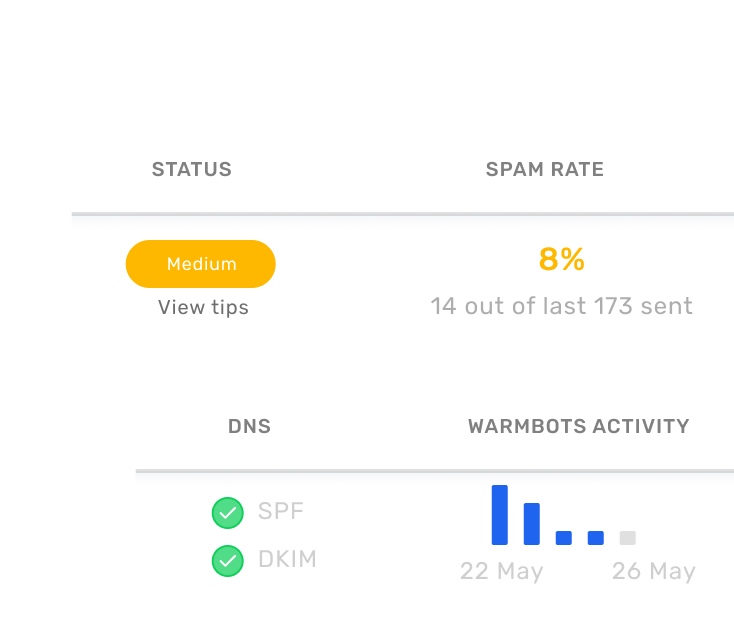Anyone and everyone involved in the world of email marketing needs to know about email deliverability. A pivotal metric, it has an important role in the success or failure of email marketing campaigns. This guide will introduce you to the concept of email deliverability and show you why it matters.
So, what is email deliverability?
In simple terms, email deliverability indicates how likely an email message is to reach the addressee’s inbox.
But wait, aren’t they all supposed to land in their inbox?
Well, not exactly.
Different email providers have different systems for SPAM filters and traps – each can result in your emails being delivered to your subscribers’ dreaded SPAM folder instead of their inbox. And that’s obviously not ideal.
Not only does it mean that your email messages aren’t being seen by your prospects, but it can also negatively impact your sender reputation which can further hurt your exposure.
Email deliverability refers to the rate or likelihood of emails being successfully delivered to a recipient’s inbox past these barriers, and is often used as a gauge to measure an email marketing campaign’s overall effectiveness.
Email deliverability vs. delivery – what’s the difference?
Although they sound the same and are often confused with one another, it’s important to make the distinction between them: email delivery and email deliverability are not the same thing.
They are two different indicators, each pertaining to their own specific purpose and meaning. Below, you will find a quick explanation of each of them and what they mean in relation to email campaigns.
What is email delivery?
Email delivery is just that – delivery. It indicates that a message has been sent from a sender address and has been accepted by the receiving email servers.
There are quite a few factors that can interfere with delivery, including Internet Service Providers, SPAM traps, throttling and bounces.
Once the message has been delivered to the mail server, it’s then up to the deliverability email processing algorithms of mailbox providers to decide whether or not it goes into the inbox, the SPAM folder, or is rejected altogether.
In other words, delivery has more so to do with the literal success of sending an email as opposed to it being placed where you want it to be.
Email deliverability
Email deliverability, on the other hand, looks at how successful an email marketing campaign is at placing delivered emails into prospects’ inboxes.
This varies significantly from email to email and is dependent on a variety of different factors that we’ll get into later in this article.
It’s important to measure both your delivery rate and deliverability, because a high delivery rate doesn’t necessarily mean you have high deliverability, and vice versa.
A low delivery rate with a high deliverability means that you’re very good at inbox placement, while a high delivery rate with low deliverability means that you’re not.
It is impossible to 100% guarantee email deliverability, but a professional approach can minimize SPAM issues and ensure that your emails will reach the inboxes.
That is why a decision to use professional email deliverability services might be a good idea if you are experiencing problems with your outbound campaigns.
At Growbots, the email deliverability services are provided by experts with years of experience in maximizing deliverability rates.
Warm-Up for Predictable Outcomes
Reach Inboxes, Not Spam Folders
- NO Cost for 3 Inboxes
- Monitoring
- For all email providers
- Deliverability Testing
your email setup check
Be compliant with the newest Google & Yahoo regulations
- SPF Record CHECk & setup
- DKIM Record Check & Setup
- DMARC Policy Setup
- Creating a new custom domain
Why is email deliverability important?
There are a number of reasons as to why email marketers track their email deliverability. Here are a few of the most pertinent.
Gauging performance
For starters, it’s a good way to gauge the performance of your email marketing campaigns.
If you see a sudden drop in deliverability, it could be indicative of a problem with your campaign, account’s IP address, or even invalid addresses on your recipient list that need to be fixed.
Conversely, if you see a spike in deliverability, it could mean that you’re doing something right and you can continue to replicate that behavior in future email campaigns.
Improving ROI
Secondly, monitoring your email deliverability rate can also help you improve your ROI.
After all, if your emails are being seen as SPAM or being rejected altogether, it’s not doing you any good.
By paying attention to your deliverability rate and making the necessary changes to improve it, you can ensure that more of your emails are actually being seen by prospects, which in turn can lead to more sales and conversions.
Maintaining sender reputation
Lastly, email deliverability is also important from a sender reputation standpoint.
Your sender reputation is essentially your score or rating as an email sender and is used by Internet Service Providers to determine whether or not your emails should be delivered to the receivers’’ inboxes.
The higher your score, the more likely it is that your emails will be delivered.

What affects email deliverability?
As we mentioned earlier, there are a number of different factors that can affect email deliverability. Here are a few of the most common ones.
Sender reputation
As we have just touched on, your email sender reputation is one of the most important factors when it comes to email deliverability.
Your sender reputation is determined by a number of different things, including your sending history, complaint rate, unsubscribe rate, and more.
If your sender score and domain reputation starts to dip, it’s important to take action to improve it as soon as possible, otherwise, you run the risk of having your emails blocked or sent to a SPAM folder.
Email authentication
Another factor that can affect your email deliverability is email authentication.
Email authentication is the process of verifying whether an email is actually coming from who it says it’s coming from.
This can be done through a number of different methods, including SPF, DKIM, and Domain Based Message authentication (DMARC).
ISPs are increasingly using authentication as a way to determine whether or not an email is legitimate.If you’re not authenticating your emails, there’s a good chance that they’ll end up in the recipient’s SPAM folder.
Email content
The content of your emails can also affect deliverability.
For example, if you’re sending emails with a lot of images or embedded links, there’s a chance that they could be marked as SPAM by ISP filters.
It’s important to strike a balance with your email content. Include enough images and links to make your emails visually appealing and engaging, but don’t go overboard, as that could end up causing deliverability issues.
Email subject line
Besides the content of your cold emails, there are other elements that play a crucial role in email deliverability: their subject lines. They have a significant impact on whether an email gets delivered to the email addresses on your email list or ends up in the spam folder.
An engaging and relevant subject line can help prevent an email from a soft bounce, reduce spam complaints, and avoid landing in spam traps.
If you want to capture the attention of your recipients, and consequently increase your open rates and lower bounce rates, you should avoid using spammy or misleading subject lines that could harm your deliverability.
To be precise, you should for example avoid adding words and phrases that trigger spam filters such as: free, earn $$$, don’t delete, earn cash, urgent, or no cost.
Read also: Inbound vs outbound sales – what’s the difference and how to connect them both
Relevance in email outreach is key. This is why you should use email subject lines that will help you build trust with your prospects. Next time you send an email campaign, try adding your prospect’s name or company name in the subject line.
Email frequency
Another thing that can affect email deliverability is email frequency.
This is the number of emails that you send in a given period of time. If you’re sending too many, you’re at an increased likelihood of subscribers starting to mark them as SPAM emails.
Conversely, if you’re not sending enough emails, your mailing list could become inactive which could also hurt your deliverability. It’s crucial to find a happy medium when it comes to email frequency.
User engagement
Last but not least, the engagement with other email accounts is also a factor that affects email deliverability.
If your messages are regularly being opened and your links are being clicked, the ISPs will take that as a good sign showing that you are a legitimate sender.
In effect, your emails will be more likely to be delivered in the future. On the other hand, lack of engagement from your emails’ receivers can lead to your messages being flagged as SPAM.
How to measure email deliverability
Determining email deliverability rates can be quite complex.
There is a number of different factors that can affect it, as we have just discussed.
If you’re not using an email marketing platform that will measure it for you, paying attention to the following key metrics can be helpful in gauging your deliverability.
- Delivery Rate: Your delivery rate is the percentage of emails that are successfully delivered to subscribers’ inboxes.
- Open Rate: Your open rate is the percentage of subscribers who open your emails.
- Click-Through Rate: Your click-through rate (CTR) is the percentage of subscribers who click on at least one link in your email.
- SPAM Complaint Rate: Your SPAM complaints rate is the percentage of subscribers who mark your email as SPAM.
- Unsubscribe Rate: Your unsubscribe rate is the percentage of uninterested or inactive subscribers who unsubscribe from your email list after receiving one of your emails.
How to test email deliverability
Some people may consider email deliverability as a quite complex concept, and there’s a lot that goes into enhancing it. A good way to test your email marketing strategy and see if it’s up to par is by running it through an email deliverability test, which will evaluate its inbox placement.
As we mentioned before, you can also decide to use professional help with this. For instance the email deliverability services at Growbots include a special email warm up tool and a team of experts who monitor the deliverability of the sent campaigns on a daily basis.
Warm-Up for Predictable Outcomes
Reach Inboxes, Not Spam Folders
- NO Cost for 3 Inboxes
- Monitoring
- For all email providers
- Deliverability Testing
your email setup check
Be compliant with the newest Google & Yahoo regulations
- SPF Record CHECk & setup
- DKIM Record Check & Setup
- DMARC Policy Setup
- Creating a new custom domain
How to improve email deliverability
There are a number of different ways to improve email deliverability. We’ve listed some of the most effective methods below.
- Use A Professional Email Service Provider: One way to improve your email deliverability is to use professional email service providers (ESP). Email Service Providers are designed specifically for sending emails and have the infrastructure in place to help you store email addresses, follow a good IP address sender policy framework, as well as ensure that your emails avoid the pitfalls of a server SPAM trap.
- Follow Email Best Practices: Another way to improve your email deliverability is to follow email best practices. This includes things like keeping your list clean and up-to-date, authenticating your emails, and of course providing an unsubscribe link to those who prefer not to receive your communications.
- Monitor Your Email Metrics: As we mentioned before, monitoring your email metrics is a good way to gauge your deliverability. Pay attention to things like your delivery rate, open rate, CTR, complaint rate, and unsubscribe rate. If you see any red flags, that’s an indication that you need to make some changes to improve your deliverability.
Email deliverability can be impacted by a number of factors, including email sender reputation, mail server IP addresses, a message’s subject line, content, and more. By informing yourself on the common factors affecting email deliverability and understanding how the system works, you can make your email campaigns as effective and successful as possible.

Chris Traczyk
Deliverability Expert at Growbots























